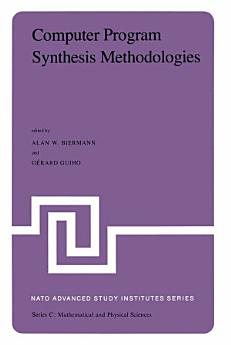Computer Program Synthesis Methodologies: Proceedings of the NATO Advanced Study Institute held at Bonas, France, September 28–October 10, 1981
A.W. Biermann · G. Guiho
ທ.ວ. 2012 · Nato Science Series C ຫົວທີ 95 · Springer Science & Business Media
ປຶ້ມອີບຸກ
374
ໜ້າ
reportບໍ່ໄດ້ຢັ້ງຢືນການຈັດອັນດັບ ແລະ ຄຳຕິຊົມ ສຶກສາເພີ່ມເຕີມ
ກ່ຽວກັບປຶ້ມ e-book ນີ້
powerful operations on them. An early step in this direction was the development of APl, and more recent examples have been SETl which enables a user to code in terms of mathematical enti ties such as sets and BDl which allows a user, presumably a businessman, to specify a computation in terms of a series of tabular forms and a series of processing paths through which data flows. The design and implementation of such languages are examined in chapters by P. GOLDBERG. Another extension to traditional methods is made possible by systems designed to automatically handle low level flow-of control decisions. All the above higher level languages do this implicitly with their built in operators. PROLOG is a language which does this with a theorem proving mechanism employing primarily unification and backtracking. The programmer specifies the problem to be solved with a set of formal logic statements including a theorem to be proved. The theorem proving system finds a way to combine the axioms to prove the theorem, and in the process, it completes the desired calculation. H. GAllAIRE has contributed a chapter describing PROLOG giving many examples of its usage.
ໃຫ້ຄະແນນ e-book ນີ້
ບອກພວກເຮົາວ່າທ່ານຄິດແນວໃດ.
ອ່ານຂໍ້ມູນຂ່າວສານ
ສະມາດໂຟນ ແລະ ແທັບເລັດ
ຕິດຕັ້ງ ແອັບ Google Play Books ສຳລັບ Android ແລະ iPad/iPhone. ມັນຊິ້ງຂໍ້ມູນໂດຍອັດຕະໂນມັດກັບບັນຊີຂອງທ່ານ ແລະ ອະນຸຍາດໃຫ້ທ່ານອ່ານທາງອອນລາຍ ຫຼື ແບບອອບລາຍໄດ້ ບໍ່ວ່າທ່ານຈະຢູ່ໃສ.
ແລັບທັອບ ແລະ ຄອມພິວເຕີ
ທ່ານສາມາດຟັງປຶ້ມສຽງທີ່ຊື້ໃນ Google Play ໂດຍໃຊ້ໂປຣແກຣມທ່ອງເວັບຂອງຄອມພິວເຕີຂອງທ່ານໄດ້.
eReaders ແລະອຸປະກອນອື່ນໆ
ເພື່ອອ່ານໃນອຸປະກອນ e-ink ເຊັ່ນ: Kobo eReader, ທ່ານຈຳເປັນຕ້ອງດາວໂຫຼດໄຟລ໌ ແລະ ໂອນຍ້າຍມັນໄປໃສ່ອຸປະກອນຂອງທ່ານກ່ອນ. ປະຕິບັດຕາມຄຳແນະນຳລະອຽດຂອງ ສູນຊ່ວຍເຫຼືອ ເພື່ອໂອນຍ້າຍໄຟລ໌ໄໃສ່ eReader ທີ່ຮອງຮັບ.








